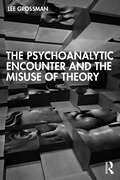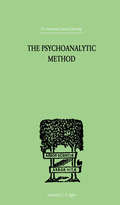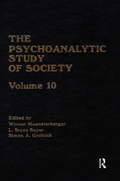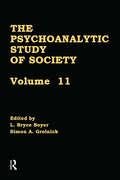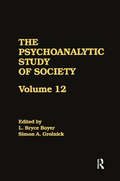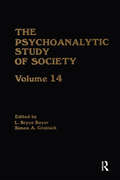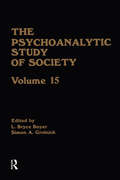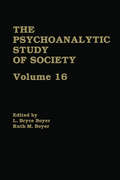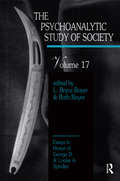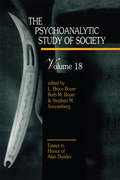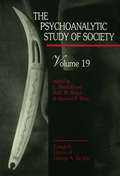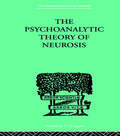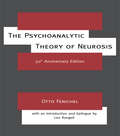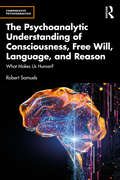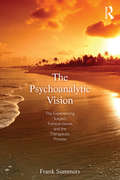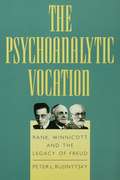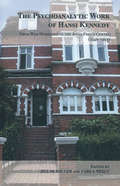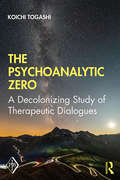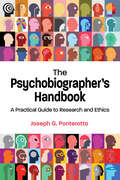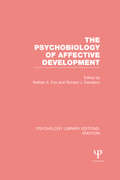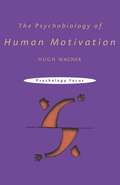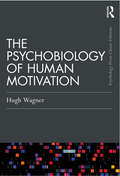- Table View
- List View
The Psychoanalytic Encounter and the Misuse of Theory
by Lee GrossmanIn clear, accessible language, Lee Grossman addresses the disjuncture between analytic literature and clinical work in an effort to render analytic theorizing more representative of clinical experience. Pointing out the ways in which analytic literature can fail to capture the intensity of feeling and the stumbling, lurching, working in the dark that captures much of clinical engagement, Grossman shows how incomprehensibility is sometimes mistaken for wisdom. As an alternative, Grossman shows how attention to what he calls the syntax of thought can naturally define three different broad categories of life experience: the omnipotence of the neurotic, the wishful, short-sighted thinking of the perverse, and the concrete, disordered thinking of the psychotic. Using rich clinical material, interspersed with detailed exposition and artful satire, Grossman departs from conventional theoretical writing to provide new ways of conceptualising analytic therapy. Addressing analytic therapy as an encounter between two people, both governed by forces about which they know very little, this book provides essential insights for psychoanalysts, psychotherapists and other clinical practitioners both in training and in practice.
The Psychoanalytic Method
by Pfister, OskarFirst Published in 1999. Routledge is an imprint of Taylor & Francis, an informa company.
The Psychoanalytic Study of Society, V. 10
by Werner Muensterberger, L. Bryce Boyer and Simon A. GrolnickFirst published in 1983. Volume 10 of the Psychoanalytic Study of Society papers. with essays on anthropology, religion, history, literature, and music.
The Psychoanalytic Study of Society, V. 11: Essays in Honor of Werner Muensterberger
by L. Bryce Boyer and Simon A. GrolnickVolume 11 includes chapters on the analysis of dybbuk possession and exorcism in Judaism (Y. Bilu); crisis and continuity in the personality of an Apache shaman (L. B. Boyer et al.); culture shock and the inability to mourn ( H. Stein); charismatically led groups (L. Balter); the psychoanalytic and social aspects of telephoning (R. Almansi); and an ethnographic study of hermaphroditism ((G. Herdt & R. Stoller).
The Psychoanalytic Study of Society, V. 12: Essays in Honor of George Devereux
by L. BRYCE BOYER; SIMON A. GROLNICKVolume 12 includes chapters on the hermeneutics of structuralism and psychoanalysis (H. van Velzen); prophetic initiation in Israel and Judah (D. Merkur); the cult phenomenon and the paranoid process (W. Meissner); the ego and adaptation (P. Parin); male adolescent initiation rituals (L. Rosen); gender identity in a New Guinea people (E. Foulks); and the film Cabaret (S. Bauer).
The Psychoanalytic Study of Society, V. 13: Essays in Honor of Weston LaBarre
by L. Bryce Boyer Simon A. GrolnickVolume 13 includes chapters on the contributions of Weston LaBarre (B. Kilbourne); Geza Roheim's theory of myth (S. Morales); the origins of Christianity (W. Meissner); myths in Inuit religion (D. Merkur); the psychology of a Sherpa shaman (R. Paul); the psychoanalytic study of urban legends (M. Carroll); and the dogma of technology (H. Stein & R. Hill).
The Psychoanalytic Study of Society, V. 14: Essays in Honor of Paul Parin
by L. Bryce Boyer Simon A. GrolnickVolume 14 includes chapters on the psychoanalysis of political commitment (P. Parin); Jews and homosexuals as strangers (P. Parin); the analogous tasks of the psychoanalyst and the ethnographer (M. Gehrie); cultic elements in early Christianity (W. Meissner); Jewish apocalyptists (D. Merkur); creationist resistance to evolution (R. Graber & L. McWhorter); sacred objects and transitional phenomena in aboriginal Central Australia; and a review of the contributions of Paul Parin (D. Freeman).
The Psychoanalytic Study of Society, V. 15: Essays in Honor of Melford E. Spiro
by L. Bryce Boyer Simon A. GrolnickVolume 15 features Melford Spiro's "Culture and Human Nature" and "The internalization of Burmese Gender Identity" along with an interview of Spiro by B. Kilbourne and S. Bolle. Additional topics include children's fantasy life in Papua New Guinea (F. Poole); a psychoanthropological approach to Kagwahiv food taboos (W. Kracke); an ethnological and Rorschach study of three groups of Australian aborigines (R. Boyer et al.); a consideration of the "trickster" in relation to issues of sublimation and psychosocial development; and a review of Bettelheim's contribution to anthropology (R. Paul).
The Psychoanalytic Study of Society, V. 16: Essays in Honor of A. Irving Hallowell
by L. Bryce Boyer Ruth M. BoyerVolume 16 offers appreciations of A. Irving Hallowell by M. Spiro, R. Fogelson, and E. Bourguignon. Additional topics include Kagwahiv dream beliefs (W. Kracke); experiences of the self in Papua New Guinea (F. Poole); house design and the self in an African culture (R. & S. LeVine); circumcision and biblical narrative (M. Lansky & B. Kilborne); and cultic elements in early Christianity (W. Meissner).
The Psychoanalytic Study of Society, V. 17: Essays in Honor of George D. and Louise A. Spindler
by L. Bryce Boyer Ruth M. Boyer Stephen M. SonnenbergIn Volume 17, a series of critical appreciations of George and Louise Spindler's multidisciplinary contributions focus on homogeneity and heterogeneity in American cultural anthropology (S. Parman); the molding of American anthropology (M. Suarez); education (H. Trueba); and the uses of projective techniques in the field (R. Edgerton & G. DeVos). Additional topics include the primary process (M. Spiro); psychotherapy and culture (L. Bloom); unconscious aspects of the Arab-Israeli conflict (A. Falk); and medieval messianism and Sabbatianism (W. Meissner).
The Psychoanalytic Study of Society, V. 18: Essays in Honor of Alan Dundes
by L. BRYCE BOYER, RUTH M. BOYER AND STEPHEN M. SONNENBERGOpening with a critical appreciation of Alan Dundes (M. Carroll) and Dundes's own cross-cultural study of the cockfight, Volume 18 includes chapters on psychoanalysis and Hindu sexual fantasies (W. Doniger); the modern folk tale "The Boyfriend's Death" (M. Carroll); a gruesome Eskimo bedtime story (R. Boyer); the homosexual implications of Argentinean soccer (M. Suarez-Orozco); and the symbolism of a Malaysian religious festival (E. Fuller).
The Psychoanalytic Study of Society, V. 19: Essays in Honor of George A. De Vos
by L. Bryce Boyer Ruth M. Boyer Howard F. SteinCritical appreciations of George A. De Vos, a pioneer in the cross-cultural application of projective techniques (M. Suarez-Orozco, P. Lerner), and De Vos's own reminiscences, are followed by contributions true to the spirit of De Vos's methodology. They include a demonstration of the usefulness of projective tests in the psychodiagnostic evaluation of schizophrenia (J. Stone, P. Wilson & B. Boyer); an examination of the role of historical events in the development of Chinese and Japanese personality characteristics (J. Connor); a review of the impact of Freudian and Jungian thought in India (S. Kakar); and a study of loss and grief in a community of the North American Great Plains (H. Stein).
The Psychoanalytic Theory Of Neurosis (International Library Of Psychology Ser.)
by Otto FenichelRoutledge is now re-issuing this prestigious series of 204 volumes originally published between 1910 and 1965. The titles include works by key figures such asC.G. Jung, Sigmund Freud, Jean Piaget, Otto Rank, James Hillman, Erich Fromm, Karen Horney and Susan Isaacs. Each volume is available on its own, as part of a themed mini-set, or as part of a specially-priced 204-volume set. A brochure listing each title in the "International Library of Psychology" series is available upon request.
The Psychoanalytic Theory of Neurosis
by Otto Fenichel Leo RangellA perennially best-selling and influential psychoanalytic work. When Otto Fenichel died suddenly at age 48, Anna Freud mourned the loss of "his inexhaustible knowledge of psychoanalysis and his inimitable way of organizing and presenting his facts." These qualities shine in his classic text, which has been a beacon to generations of psychoanalysts. Investigating the relationship between biological needs and external influences--the tensions and inhibitions that nurture neuroses--Fenichel concludes that "neuroses are social diseases," arising from the demands of civilization on the developing organism. For this 50th anniversary edition, distinguished psychoanalyst Leo Rangell has written an introduction to set the context of Fenichel's work and an epilogue to describe its influence.
The Psychoanalytic Theory of Neurosis (International Library Of Psychology Ser.)
by Otto FenichelThe Psychoanalytic Theory of Neurosis, Fenichel's classic text, summarized the first half century of psychoanalytic investigation into psychopathology and presented a general psychoanalytic theory of neurosis. When Otto Fenichel died, Anna Freud mourned the loss of 'his inexhaustible knowledge of psychoanalysis and his inimitable way of organizing and presenting his facts'. These qualities shine through The Psychoanalytic Theory of Neurosis which has been a standard reference for generations of psychoanalysts. For this anniversary edition, Leo Rangell has written an introduction that sets Fenichel's work in context. He sees Fenichel as a worthy heir to Freud; both men influenced their followers by what Rangell calls 'the charisma of ideas'. In his epilogue, Rangell describes the fate of Fenichel's ideas and of this book as 'a barometer of the place of psychoanalysis ... within the external intellectual world and, even more significantly, of the trends and shifting winds of opinion within the psychoanalytic field itself'. He traces those trends through the turbulent controversies of the field, concluding that Fenichel's observations are as fresh and relevant today as they were fifty years ago.
The Psychoanalytic Therapy of Severe Disturbance (The\psychoanalytic Ideas Ser.)
by Paul WilliamsThis book presents the proceedings of the of the conference on the Psychoanalytic Therapy of Severe Disturbance held in Belfast in June 2008. The aim of the conference was to offer a state of the art communication of the key psychoanalytic thinking and approaches to the conceptualisation and treatment of severe disturbance. The result of a unique gathering of the most eminent psychoanalysts in the field with insights into their work on personality disorder, psychotic states and the nature and function of suicidal ideation.This book will be of interest to mental health professionals - psychiatrists, psychoanalysts, psychotherapists, psychologists, social workers and nurses who have an interest in psychoanalysis and psychotherapy.
The Psychoanalytic Understanding of Consciousness, Free Will, Language, and Reason: What Makes Us Human? (Comparative Psychoanalysis)
by Robert SamuelsThe Psychoanalytic Understanding of Consciousness, Free Will, Language, and Reason examines the ways in which we can use psychoanalysis in order to better understand humanity and explores the question of what makes us human. For thousands of years, thinkers have been trying to define what makes us human. Some of the main questions they have asked is: What is consciousness? Do we have free will? Do animals use language? And what does reason mean? Samuels argues that we need to better understand the psychoanalytic approach to human nature in order to answer these questions, as well as using it to provide a new way of understanding issues such as addiction, political conflict, ideology, and destructive personal relationship. This book will be of vital interest to psychotherapists, as well as students and researchers across the fields of psychoanalysis, philosophy, and psychology.
The Psychoanalytic Vision: The Experiencing Subject, Transcendence, and the Therapeutic Process
by Frank SummersPsychoanalytic therapy is distinguished by its immersion in the world of the experiencing subject. In The Psychoanalytic Vision, Frank Summers argues that analytic therapy and its unique epistemology is a worldview that stands in clear opposition to the hegemonic cultural value system of objectification, quantification, and materialism. The Psychoanalytic Vision situates psychoanalysis as a voice of the rebel, affirming the importance of the subjective in contrast to the culture of objectification. Founded on phenomenological philosophy from which it derives its unique epistemology and ethical grounding, psychoanalytic therapy as a hermeneutic of the experiential world has no role for reified concepts. Consequently, fundamental analytic concepts such as "the unconscious" and "the intrapsychic," are reconceptualized to eliminate reifying elements. The essence of The Psychoanalytic Vision is the freshness of its theoretical and clinical approach as a hermeneutic of the experiential world. Fundamental clinical phenomena, such as dreams, time, and the experience of the other, are reformulated, and these theoretical shifts are illustrated with a variety of vivid case descriptions. The last part of the book is devoted to the surreptitious role beliefs and values of contemporary culture play in many forms of psychopathology. For clinicians, The Psychoanalytic Vision offers a fresh clinical theory based on the consistent application of the subjectification of human experience, and for scholars, a worldview that provides the framework for a potentially fruitful cross-fertilization of ideas with cognate disciplines.
The Psychoanalytic Vocation: Rank, Winnicott, and the Legacy of Freud
by Peter L. RudnytskyObject relations, which emphasizes the importance of the preoedipal period and the infant-mother relationship, is considered by many analysts to be the major development in psychoanalytic theory since Freud. In this reinterpretation of its history Peter L. Rudnytsky focuses on two pivotal figures: Otto Rank, one of Freud's original and most brilliant disciples, who later broke away from psychoanalysis, and D. W. Winnicott, the leading representative of the Independent tradition in British psychoanalysis. Rudnytsky begins with an overview arguing that object relations theory can synthesize the scientific and hermeneutic dimensions of psychoanalysis. He the uses the ideas of Rank and Winnicott to uncover the preoedipal aspects of Sophocles' Oedipus the King. After an appraisal of the relationship between Rank and Freud, he turns to Rank's neglected writings between 1924 and 1927 and shows how they anticipate contemporary object relations theory. Rudnytsky critically measures Winnicott's achievement against those of Heinz Kohut and Jacques Lacan, the founders of two competing schools of psychoanalysis, and compares Winnicott's life and work with Freud's. Next, using both published and unpublished accounts by the psychotherapist Harry Guntrip of his analyses with W. R. D. Fairbairn and Winnicott, he probes the personal and intellectual interactions among these three British clinicians. Rudnytsky concludes by advancing a psychoanalytic theory of the self as a rejoinder to the postmodernism that is the dominant ideology in literary studies today. In two appendices he makes available for the first time an English translation of Rank's "Genesis of the Object Relation" and a 1983 interview with Clare Winnicott.
The Psychoanalytic Work of Hansi Kennedy: From War Nurseries to the Anna Freud Centre (1940-1993)
by Jill M. Miller Carla NeelyThis book presents a selection of the works of Hansi Kennedy, preeminent child psychoanalyst, whose career began with Anna Freud in the Hampstead War Nurseries and continued at the Hampstead Child Therapy Clinic (renamed the Anna Freud Centre in 1982) until retirement in 1993. Her career spanned a significant period in the development of child psychoanalysis, as her ideas foreshadowed a number of advances in theory during the period which have had a profound impact on child psychoanalytic technique.
The Psychoanalytic Zero: A Decolonizing Study of Therapeutic Dialogues (Psychoanalytic Inquiry Book Series)
by Koichi TogashiThe Psychoanalytic Zero: A Decolonizing Study of Therapeutic Dialogues is written from the unique perspective of a Western-trained Asian psychoanalyst and applies principles of Eastern philosophy to understand the psychoanalytic relationship, psychoanalytic processes, and their uses—and limitations—for alleviating human suffering. Bringing a unique Eastern perspective to a previously Western-dominated discipline and framed within the current relational and ethical trends in psychoanalysis, the book enables readers to develop a language for understanding an Eastern ethical viewpoint and explore how this language can change our awareness of psychoanalytic practice and human suffering. Chapters are devoted to the Eastern concepts of nothingness, emptiness, surrender, sincerity, silence and narrative, and issues including existential "guilt of being," trauma, contingency, informed consent, the sense of being human, and uncertainty. Discussions are illustrated and illuminated through vivid recreations and careful elaboration of therapeutic case studies with traumatized patients. The studies demonstrate the process by which patients regain a sense of being human. This enriched perspective will, it is hoped, help the analyst treat traumatized patients who are unable to relate to others, and who do not experience themselves as being human. The Psychoanalytic Zero will enrich an analyst’s sensitivity to the appearance of the moment without context—the psychoanalytic zero—which opens infinite opportunities for continued growth in a psychoanalytic relationship. It will be of great appeal to psychoanalysts and psychoanalytic psychotherapists interested in self-psychological, intersubjective, and relational theories.
The Psychobiographer's Handbook: A Practical Guide to Research and Ethics
by Joseph G. PonterottoA practical guide to conducting psychobiography, including the theory, methods, and ethical considerations required for research and writing.
The Psychobiology of Affective Development (Psychology Library Editions: Emotion)
by Nathan A. Fox Richard J. DavidsonOriginally published in 1984, this was the first volume on this topic to appear in an emerging area of study at the time. The editors were selective in choosing their contributions to the volume to ensure that both the developmental and neuropsychological domains were well represented. One of the major goals was to foster greater contact and cross-fertilization between subdisciplines that they firmly believed should be more intimately connected. The result is this title, which can now be enjoyed in its historical context.
The Psychobiology of Human Motivation
by Hugh WagnerWhy is one person motivated to create a business empire whilst another is inspired to produce a beautiful work of art? Why do some people prefer a quiet life?The Psychobiology of Human Motivation explores what directs our behaviour, from basic physiological needs like hunger and thirst to more complex aspects of social behaviour like altruism. Hugh Wagner explores the limits of biological explanations and shows how humans can influence `basic' physiological drives in order to adapt to a complex social environment.
The Psychobiology of Human Motivation (Psychology Press & Routledge Classic Editions)
by Hugh WagnerThis is a classic edition of Hugh Wagner’s influential overview of the biopsychological underpinnings of human motivation. It includes a new foreword written by Michael Richter who reflects on Wagner’s 20 years of teaching, writing and research in the field of biopsychology and promises an engaging, succinct and accessible introductory text that remains relevant and useful to students today. The Psychobiology of Human Motivation explores what directs our behaviour, from basic physiological needs like hunger and thirst to more complex aspects of social behaviour like altruism. Wagner explores the limits of biological explanations and shows how humans can influence ‘basic’ physiological drives in order to adapt to a complex social environment. An accessible, engaging resource strengthened by many applied examples, Wagner’s text continues to be integral reading for undergraduate students seeking a solid introduction to the psychology of human motivation across the social and behavioural sciences.
